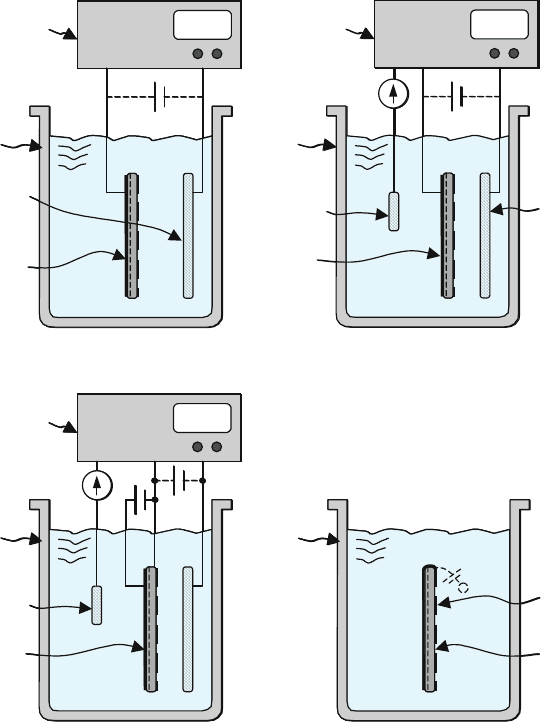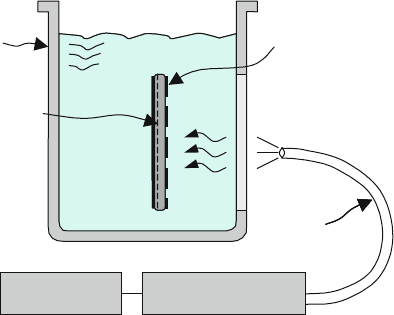Ghodssi R., Lin P., MEMS Materials and Processes Handbook
Подождите немного. Документ загружается.


594 D.W. Burns
Table 8.25 Ion-implanted silicon etch stops and processes
Material
Etch rate
reduction Etchant Remarks and references
1 Silicon (Si),
(100),
implanted
boron (B)
EDP, KOH, N
2
H
4
,
NH
4
OH, TMAH
Implanted boron etch stop; see Table 8.23 [475, 477]
2 Silicon (Si),
(100),
implanted
oxygen (O)
EDP, KOH(33 wt%),
KOH-IPA
Implanted oxygen etch stop (SiO
2
); implanted O
+
with heated
substrate (550
◦
C plus self-heating); 1.1 × 10
18
cm
−2
dosage at
100 keV for 60-min etch stop in EDP; 1.2 × 10
18
cm
−2
dosage for
60-min etch stop in KOH-IPA; no postimplant anneal [478]
3 Silicon (Si),
(100),
implanted
nitrogen (N)
EDP, KOH(33 wt%),
KOH-IPA
Implanted nitrogen etch stop (Si
3
N
4
); implanted N
+
with heated
substrate (550
◦
C plus self-heating); 1.0 × 10
18
cm
−2
dosage at
200 keV for 60-min etch stop in EDP or KOH-IPA;
1.1 × 10
18
cm
−2
dosage for 60-min etch stop in KOH etchant (33
wt%); no postimplant anneal; high-temperature anneal needed for
additional epi depositions; etch-rate reductions seen at
5.0 ×10
16
cm
−2
N at 120 keV with or without annealing [478, 479]
4 Silicon (Si),
(100)
3.5E20 cm
–3
(C)
5.0E20 cm
–3
(C)
1.5E21 cm
–3
(C)
4.0E21 cm
–3
(C)
0.02
0.01
0.001
0.0002
Ethylenediamine:
pyrocatechol:
pyrazine:H
2
O
1000 mL:160 g:
6 g:133 mL
85
◦
C; EDP etchant, type S; implanted carbon etch stop (SiC);
implanted C
12
with nonheated substrate; 35 keV; 850
◦
C
postimplant anneal [480]
5 Silicon (Si),
(100)
3.0E20 cm
–3
(C)
2.5E21 cm
–3
(C)
4.5E21 cm
–3
(C)
8.0E21 cm
–3
(C)
2.0E22 cm
–3
(C)
0.5
0.1
0.01
0.001
0.0001
KOH:H
2
O
800 g:1000 mL
85
◦
C; KOH etchant (45 wt%); implanted carbon etch stop (SiC);
implanted C
12
with nonheated substrate; 35 keV; 850
◦
C
postimplant anneal [480]
8 MEMS Wet-Etch Processes and Procedures 595
during the elevated temperatures associated with epi growth and that a satisfactory
seed layer for the epi deposition exists at the implanted surface.
8.6.5 Electrochemical Etching and Electrochemical Etch Stops
Although applicable to nearly any metal or semiconductor material, electrochemical
etching techniques generally require external voltage supplies, monitors, reference
electrodes, and one or more electrical connections to each wafer, which diminish
their utility in favor of simple immersion in selective wet chemical etchants or use of
dry-etching systems. However, in situations where a well-defined etch stop is needed
between n-doped and p-doped material, the additional efforts may be worthwhile.
An example is bulk-micromachined pressure sensors that use a low-doped n-type
diaphragm with p-type piezoresistors.
Electrochemical etch stops can provide suitable stopping capability for wafers
with an internal p–n junction, such as a lightly doped epitaxially deposited n-type epi
layer on top of a p-type substrate. The doping requirements for the p
–
and n
–
sides
are much reduced from heavy p
++
etch stops and allows for piezoresistors and active
devices. Accommodations must be made to provide good electrical contact to the
internal junction, while protecting the connections from inadvertent exposure to the
etchant. When etching at an elevated temperature, reverse leakage currents increase
and can lessen the voltage drop across the diode. High current levels present during
portions of the etch may cause variations in voltage across the wafer and prevent
the etch from stopping near the junction, requiring metal backing plates, metallized
pathways, or regions on the wafer with very low sheet resistance to circumvent.
Two-, three-, four-, and zero-electrode configurations with intrinsic galvanic cou-
ples are possible for silicon etching. Two-electrode configurations require a voltage
be applied across the n-epi and a reference electrode placed in the etchant as seen
in Fig. 8.13a, although this approach is intolerant of leaky junctions and may fail
to etch or fail to stop the etch where desired. The three-electrode configuration
uses a reference electrode such as a platinum sheet, mesh, or wire, in addition to
connections to the n-epi and counterelectrode as seen in Fig. 8.13b. By setting a
potentiostat so that the current through the reference electrode is zero, the interface
potential between the reference electrode and the etchant is stable and less subject
to variations in leakage currents or s horting in the sample, resulting in a more con-
sistent etch stop. The four-electrode configuration requires an additional connection
to the p-type substrate as seen in Fig. 8.13c and is more tolerant of substrate leak-
age, although it requires the most connections and external monitoring. As the etch
nears completion, the current changes dramatically, bubble formation at the silicon
surface or near the counter electrode stops, a smooth surface becomes visible, and
the wafer can be withdrawn and rinsed. A zero-terminal configuration is illustrated
in Fig. 8.13d. This configuration self-generates the required galvanic potentials by
incorporating, for example, thin-film platinum on the front and/or back of a wafer
with sufficient area to stop the etch as an internal p–n junction is reached. Internal

596 D.W. Burns
Etch
Bath
Etchant
Counter
Electrode
(Cathode)
Wafer
Electrode
(Anode)
d) Zero-Terminal Configuration
Etch
Bath
Etchant
Counter
Electrode
Wafer
Electrode
Potentiostat
a) Two-Terminal Configuration
Etch
Bath
Etchant
Reference
Electrode
Wafer
Electrode
Potentiostat
I = 0
c) Four-Terminal Configuration
Etch
Bath
Etchant
Reference
Electrode
Counter
Electrode
Wafer
Electrode
Potentiostat
b) Three-Terminal Configuration
I = 0
Etch
Bath
Etchant
Counter
Electrode
(Cathode)
Wafer
Electrode
(Anode)
d) Zero-Terminal Configuration
Etch
Bath
Etchant
Counter
Electrode
(Cathode)
Wafer
Electrode
(Anode)
d) Zero-Terminal Configuration
Etch
Bath
Etchant
Counter
Electrode
Wafer
Electrode
Potentiostat
a) Two-Terminal Configuration
Etch
Bath
Etchant
Counter
Electrode
Wafer
Electrode
Potentiostat
a) Two-Terminal Configuration
Etch
Bath
Etchant
Reference
Electrode
Wafer
Electrode
Potentiostat
I = 0
c) Four-Terminal Configuration
Etch
Bath
Etchant
Reference
Electrode
Wafer
Electrode
Potentiostat
I = 0
c) Four-Terminal Configuration
Etch
Bath
Etchant
Reference
Electrode
Counter
Electrode
Wafer
Electrode
Potentiostat
b) Three-Terminal Configuration
I = 0
Fig. 8.13 Electrochemical etch stops require a predefined voltage across an internal p–n junc-
tion in a substrate. As a silicon wafer is etched and exposes a biased junction, the exposed n-type
material is anodized and the etch rate slows appreciably. In a two-electrode configuration (a), one
electrical connection is made to the wafer (anode or working electrode) and another to a counter-
electrode (cathode) in the etchant, and connected to an external voltage supply and current monitor.
A three-electrode configuration (b) adds a reference electrode near the working electrode, and the
counter and reference electrodes are connected to a potentiostat to monitor the process. Voltage
adjustments are made so that no current flows through the reference electrode. A four-electrode
configuration (c) has a second connection to the wafer where it can set the potential on the sub-
strate being etched in addition to the stop layer. A zero-terminal configuration (d) has a sizable
platinum film on the wafer that serves as a galvanic cell to self-bias and passivate the n-type layer
when it becomes exposed. Not shown are provisions for ohmic contact and protection for select
portions of the wafer

8 MEMS Wet-Etch Processes and Procedures 597
ohmic connections and fixtures or passivation layers to protect portions of the wafer
during etching are needed.
Judicious selection of applied voltages, current density, and etchant concentra-
tion can have a major impact on the electrochemically etched result, such as the
production of an electropolished surface or porous silicon. As in anisotropic etching
of silicon substrates with chemical etchants, the structures may become increasingly
fragile as the silicon is removed. The etchants are generally anisotropic although the
techniques work with certain isotropic etchants. The electrochemical etch stop gen-
erally applies to p-type substrates with an n-epi layer on top, however, a technique
referred to as pulsed-potential anodization (PPA) allows the etching of n-substrates
while stopping on a p-type layer [481]. Etch rates and etch stop ratios for various
etchants and configurations are listed in Tables 8.26 and 8.27. The interested reader
may consult some of the many excellent papers and books written on the subject [1,
2, 4, 78, 454].
Table 8.26 Electrochemical silicon etchants and etch processes
Material
Etch rate
(Å/s) Etchant Remarks and references
1 Silicon (Si),
(100) n
–
substrate
4.6 KOH:H
2
O
110 g:1000 mL
21
◦
C; KOH etchant (10 wt%) (2 M); 2-terminal
configuration; substrate etch rate before
application of anodization potential: ∼4.6 Å/s;
substrate etch rate with anodization potential:
∼0.009 Å/s (500:1); substrate set slightly
higher than t he passivation potential (–0.7 to
–1.1 V with respect to (wrt) a standard
calomel electrode(SCE)) where anodization
current is minimum; etch ratio degrades to
100:1 at +5 V; etch rate degrades further to
30:1 with illumination [447, 482]
2 Silicon (Si),
(100) p
–
substrate
4.6 KOH:H
2
O
110 g:1000 mL
21
◦
C; KOH etchant (10 wt%) (2 M); 2-terminal
configuration; substrate etch rate before
application of anodization potential: ∼4.6 Å/s;
substrate etch rate with anodization potential:
∼0.019 Å/s (250:1); substrate set slightly
higher than t he passivation potential (–0.7 to
–0.9 V wrt SCE) where anodization current is
minimum; etch ratio degrades to 9:1 at +5 V;
illumination has little effect on etch rate ratio
[447, 482]
8.6.6 Photoassisted Silicon Etching and Etch Stops
Photoassisted etching, also referred to as photoelectrochemical etching, allows
the selective etching and nonetching of silicon, and depends upon doping, light
intensity, and p–n regions within the silicon. The phenomenon is often observed

598 D.W. Burns
Table 8.27 Electrochemical etch stops and processes
Material
Etch rate
ratio Etchant Remarks and references
1 Silicon (Si), (100) p
–
substrate (stops on
n-diffusion)
3000:1 Ethylenediamine:
pyrocatechol:H
2
O
75mL:12g:24mL
105–115
◦
C; EDP etchant; 2-terminal configuration; Pt counterelectrode; +0.6 V
applied to n-layer; etch rate of 210–290 Å/s prior to stopping on n-type layer; etch
rate of passivated layer <0.1 Å/s after stopping [483]
2 Silicon (Si), (100) or
(111) n
+
substrate
(stops on n
–
epi)
HF(49%):H
2
O
1:9
Room temperature; DHF etchant (9:1); 2-terminal configuration; etches n
+
(111) at
550 Å/s; Pt counterelectrode; +6.0 V applied to
n
+
> 4 × 10
18
cm
−3
;n
−
< 2 × 10
16
cm
−3
; avoid illumination [484–486]
3 Silicon (Si), (100) p
–
or
p
+
substrate (stops on
n
–
implant)
HF(49%):H
2
O
1:9
Room temperature; DHF etchant (9:1); 2-terminal configuration; etches p
–
at
250 Å/s; +1.5 V applied ohmically to p
–
substrate wrt Pt counterelectrode;
n
−
<∼ 1 × 10
16
cm
−3
[487]
4 Silicon (Si), (100) p
+
substrate (stops on n
–
epi)
HF(49%):
H
2
SO
4
(96%):H
2
O
1:1:5
25–66
◦
C; HF-sulfuric e tchant; 2-terminal configuration; +0.5 V applied t o n-epi wrt
Pt counterelectrode; remove any brownish build-up with HF:HNO
3
(3:97) [488]
5 Silicon (Si), (100) p
–
substrate (stops on n
–
diffusion)
KOH:H
2
O
250 g:1000 mL
75
◦
C; KOH etchant (20 wt%); 2-terminal configuration; doping-selective etching
(DSE); 1.9 V applied to n-type region wrt Pt counterelectrode in solution (between
passivation potentials of n-type and p-type material); etches n-type material
selectively; topside or bottom side etching; technique may apply to n
+
onn[489]
6 Silicon (Si), (100) p
–
substrate (stops on n
–
epi)
90:1 KOH:H
2
O
665 g:1000 mL
60
◦
C; KOH etchant (40 wt%); 3-terminal configuration; n-type diaphragms on
p-type substrate; substrate etch rate before stop ∼55 Å/s; diaphragm e tch rate
after stop ∼0.6 Å/s; potentiostat connected to n-epi and set to –0.6 V or higher
(more positive than the oxide formation potential for n-type Si) wrt SCE;
p-substrate ideally floats to open circuit potential (OCP); SCE voltage set for 0
current through the SCE by adjusting the Pt counterelectrode voltage; current
through counter electrode is ∼0 mA while etching (for low-leakage diodes);
current increases when etch stop occurs and diminishes after anodic passivation;
sensitive to diode and parasitic leakages; avoid illumination [490, 491]

8 MEMS Wet-Etch Processes and Procedures 599
Table 8.27 (continued)
Material
Etch rate
ratio Etchant Remarks and references
7 Silicon (Si), (100) p
–
substrate (stops on n
–
diffusion or p
++
or
both)
KOH:H
2
O
1000 g:1000 mL
88
◦
C; KOH etchant (50 wt%); 3-terminal configuration (no reference electrode);
capacitive electrochemical etch stop (CECES); etches p-substrate 280 Å/s; +4.0 V
for 3 ms then 0.0 V for 0.3 ms applied to n-region via 200 k on-chip resistors
wrt p
++
substrate connections; Pt counterelectrode in solution also connected to
resistors; timing parameters based on resistor parameters, etched area, and
nonetched areas [492]
8 Silicon (Si), (100) n
–
substrate (stops on p
–
epi)
KOH:H
2
O
250 g:1000 mL
60
◦
C; KOH etchant (20 wt%); 3-terminal configuration; pulsed-potential
anodization (PPA); etches n-type regions selectively over p-type regions; apply
+2 V for 1 s to p-type layer, then apply 0 V for ∼30 s and repeat; modest
reduction in etch rate from rate at open circuit potential; avoid illumination [481]
9 Silicon (Si), (100) p
–
substrate (stops on
inverted p
–
substrate)
KOH:H
2
O
500 g:1000 mL
70
◦
C; KOH etchant (30 wt%); 3-terminal configuration;
metal-insulator-semiconductor (MIS) etch stop; homogenous p-type substrate
with 1000 Å gate oxide; +1.2 V applied to substrate contacts wrt Pt
counterelectrode in solution; +5 V gate voltage results in ∼1 µm-thick features
[493]
10 Silicon (Si), (100) p
–
substrate (stops on n
–
epi)
90:1 KOH:H
2
O
665 g:1000 mL
60
◦
C; KOH etchant (40 wt%); 4-terminal configuration; n-type diaphragms on
p-type substrate; substrate etch rate before stop ∼55 Å/s; diaphragm e tch rate
after stop ∼0.6 Å/s; potentiostat connected to p-substrate and set to –1.5 V (near
open-circuit potential) wrt standard calomel electrode (SCE); n-epi set to +1.5 V
wrt p-substrate; SCE voltage set for 0 current through the SCE by adjusting the Pt
counterelectrode voltage; current through counter electrode is ∼0mAwhile
etching (for low-leakage diodes); current increases when etch stop occurs and
diminishes after anodic passivation; less sensitive to diode leakages than
3-terminal configuration [490, 494]
11 Silicon (Si), (100) p
–
substrate (stops on n
–
epi)
>380:1 N
2
H
4
:H
2
O
1:1
90
◦
C; 50:50 hydrazine etchant; 2-terminal configuration; etches p-substrate at
530 Å/s; etches n-type layer after anodic passivation at <1.4 Å/s; Pt
counterelectrode; n-type layer biased a t +5.0 V wrt counterelectrode; 3000 Å
oxide mask over Al pads; bubbling stops when etch is completed [495, 496]

600 D.W. Burns
Table 8.27 (continued)
Material
Etch rate
ratio Etchant Remarks and references
12 Silicon (Si), (100) p
–
substrate (stops on
n-epi)
TMAH(25 wt% in
H
2
O)
80
◦
C; TMAH etchant (25 wt%); 0-terminal configuration; intrinsic galvanic cell
(IGC) etch stop; Au (2000 Å) on Cr (600 Å) with sufficient area connected to
n-epi generates internal biasing when immersed in solution [497–499]
13 Silicon (Si), (100) p
–
substrate (stops on
n-well diffusion)
TMAH(25 wt% in
H
2
O), with and
without IPA
80
◦
C; TMAH etchant (25 wt%) with 0 and 17% (by volume) IPA added; 3-terminal
and 4-terminal configurations (–1.5 V on p-substrate and +1.0 V on n-bridges);
Ag/AgCl reference electrode; Pt c ounterelectrode; reflux condenser; bubbling N
2
;
sealed wafer chuck; dip in DHF etchant prior to etching; etch in darkness; IPA has
little effect [500]
14 Silicon (Si), (100) p
–
substrate (stops on n
–
Si)
varies Aqueous alkali
(CsOH, KOH,
LiOH, NaOH,
RbOH) and others
Results vary or are unknown [501]

8 MEMS Wet-Etch Processes and Procedures 601
while etching oxide with buffered hydrofluoric acid above heavily n-doped regions
in silicon; oxide above p
+
regions will clear whereas oxide above the n
+
regions may
not. Extinguishing incident light during the last portions of the etch can diminish
or eliminate the effect [502]. Moderate levels of incident light on n-type mate-
rial in HF solutions, for example, will cause anodization and etching without any
substantial heating of the substrate. Broadband or narrowband light with energies
above the bandgap may be applied to the etched side of the wafer, although the
light can alternatively be applied to the opposite side of the wafer as generated car-
riers propagate through the wafer to the etch interface. In another configuration,
internal p–n junctions are forward biased with the application of light as in a solar
cell. Combined with judicious selection of the fraction of etched area and junction
area, p-type portions in an n-type substrate are selectively etched or preferentially
anodized and the process is stopped on the n-type material as the metallurgical junc-
tion is r eached [503]. Autogenerated potentials from thin-film metallization on the
wafer combined with external illumination allow connection-free etching of an n-
type substrate while stopping on a diffused p-layer [504], as illustrated in Fig. 8.14.
Although generally requiring no external electrical connections, electrical connec-
tions to the wafer and a potentiostat can provide the user with fuller control over
the etch process. Use of light along with external electrical connections and volt-
age control allows the production of microporous (nanoporous), mesoporous, and
macroporous silicon. Examples of photoassisted etching processes are found in
Table 8.28. Photoassisted etch stops are found in Table 8.29. Further discussions
and details may be found in the associated references and reviews [78].
Etch
Bath
Etchant
Light Source
Light
Pipe
Patterned
Wafer
PN
Junction
Modulator
Fig. 8.14 Photoassisted etch
stops use external light to
generate a photovoltage
across an internal p–n
junction and slow down the
etch rate as the junction is
exposed by the e tchant. If
passivation around the wafer
provides inadequate
protection against the etchant,
a fixture may be used
8.6.7 Thin-Film Etch Stops
Thin-film etch stops combine a deposited or otherwise formed etch-resistant layer
with a selective etchant to allow partial removal of a substrate or an adjacent film and

602 D.W. Burns
Table 8.28 Photoassisted silicon etchants and etch processes
Material
Etch
rate
(Å/s) Etchant Remarks and references
1 Silicon (Si),
(100) n
–
substrate
150–
200
HF(49%):
H
2
O
1:4
Room temperature; DHF etchant (4:1);
0-terminal configuration; photoassisted
etching (nonthermal); n-type 3E-15 cm
–3
substrate; 10 W/cm
2
optical power (UV
laser) [505]
2 Silicon (Si),
(100),
8–15 cm
415 HF(49%):
H
2
O
2:3
Room temperature; DHF etchant (3:2);
2-terminal configuration; photo-induced
preferential anodization; 500 mW/cm
2
HeNe laser source; Pt and Au
counterelectrodes; 1500:1 selectivity
enhancement over dark conditions
(0.3 Å/s) [506]
3 Silicon (Si),
(100), 2–6
cm
HF(49%):
H
2
O
1:9
15
◦
C; DHF etchant (9:1); 2-terminal
configuration; photoassisted etching;
macroporous silicon; +2 V applied to n
+
ion-implanted layer on wafer backside; Pt
wire counterelectrode; added 0.1 mM of
Triton X-100 surfactant; modulated light
intensity produced modulated pore size
with depth [507, 508]
stop automatically on the etch-stop layer. The thin film etches slowly or negligibly
in the etchant, and can simultaneously serve as a passivation layer or a hard mask.
The thin film can become free-standing, extremely fragile, and prone to buckling if
not in tension as the substrate is etched, requiring careful handling during rinsing
and subsequent handling steps.
Endpoints can be visibly detected if the etch stop material is transparent. Silicon
dioxide and silicon nitride are transparent and have high selectivity to many of
the anisotropic silicon etchants, although the oxide is generally under severe com-
pression and may distort appreciably when etched free. Although some metals
are sufficiently resistant to extended time in silicon etchants, the use of dielec-
tric thin-film stops additionally provide electrical isolation f or buried traces and
active devices while protecting the devices during the etch. Double layers of thin-
film etch stops can reduce the detrimental effects of defects such as pinholes.
The etch-stop layer may be built in, such as a buried oxide layer in an SOI
wafer. Thin-film etch stops generally allow multiple wafers to be chemically etched
simultaneously in a batch format, as illustrated in Fig. 8.15. Table 8.30 presents
some thin-film etch stops and their etch rates in some common anisotropic silicon
etchants.

8 MEMS Wet-Etch Processes and Procedures 603
Table 8.29 Photoassisted etch stops and processes
Material
Etch
rate
ratio Etchant Remarks and references
1 Silicon (Si),
(100) p
–
epi buried
layer (stops
on n
+
substrate
and n
–
surface
features)
HF(49%):H
2
O
1:4
Room temperature; DHF etchant (4:1);
0-terminal configuration;
photo-induced preferential anodization
(PIPA); forward-biased p–n junctions
to generate photocurrent; n-type
1 × 10
18
cm
−3
substrate; p-type
1 × 10
18
cm
−3
buried layer; n-type
1 × 10
15
cm
−3
beams; 30 mW/cm
2
Xenon lamp; no metal electrodes;
10 Å/s l ateral porous silicon formation
rate; remove oxidized porous silicon
layer with HF after 1000
◦
Cwet
oxidation; 20 µmwide,1µm-thick
beams formed [503]
2 Silicon (Si),
(100) n
–
substrate
(stops on
p
–
diffusion)
HF(49%):H
2
O
1:9
Room temperature; DHF etchant (9:1);
3-terminal configuration; photoassisted
etching of n-regions (1 × 10
15
cm
−3
)
around and below 3.3 µm-thick p-type
diffused structures; +4.0 V wrt SCE
applied to n-substrate via ohmic
contact; p
–
regions biased at –4.3 V wrt
n-substrate; 2 W/cm
2
illumination; etch
rate ∼400 Å/s for lower bias (+1.5 V
SCE); clear porous silicon layer with
HF:HNO
3
:Acetic 3:16:1 for 5 s or with
25 wt% KOH for 30 s at room
temperature [509, 510]
3 Silicon (Si),
(100) n
–
substrate
(stops on
p
–
epi or
diffusion)
KOH:H
2
O
500 g:1000
mL
60–75
◦
C; KOH etchant (30 wt%) (7 M);
0-terminal configuration; photovoltaic
electrochemical etch stop (PHET);
p-type diffusions (e.g., p-well); uses
topside illumination and Pt film
connected to n-regions for
electrochemical cell; no electrical
connections needed to the wafer;
restrictions on etch-stop area [504]
8.6.8 Examples: Wet Chemical and Electrochemical Etch Stops
8.6.8.1 Example 1: Anisotropic Silicon Etching of an SOI Wafer
An 8000 Å silicon nitride layer and a 1.2 µm-thick thermal oxide on the backs
and fronts of double-sided polished SOI wafers are patterned etched with large
